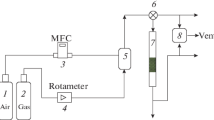Abstract
There is a need for the purification of indoor air owing to a high rate of pollution in today’s world. For this, cabin air filters (CAFs) are widely used, which requires the addition of certain adsorbents to increase the volatile organic compound (VOC) removal efficiency. However, this addition causes high-pressure resistance, which may hamper commercial applications by requiring more energy and negatively affecting fresh air delivery rate. Hence, in this study, a high-performance combined CAF (CCAF) with excellent dust and chemical filtration performance and low differential pressure was prepared using granular activated carbon (GAC)/activated carbon fiber (ACF) mixed medium. The GAC/ACF mixed medium had higher air permeability than the ACF medium of the same weight, and it exhibited similar ultrafine dust filtration performance to the ACF medium without an increase in differential pressure. In addition, the GAC/ACF mixed medium showed excellent gas removal performance without increasing differential pressure by combining the VOC removal characteristics of the GAC and ACF filter media. The improved VOC removal performance of the GAC/ACF mixed medium was due to the hybrid effect of the hierarchical pore structures of the GAC and the nearly uniform pore structures of the ACF, which resulted in a slow and increased gas adsorption by the GAC and rapid gas adsorption of the ACF.






Similar content being viewed by others
References
Bräunling V (2000) A decade of Dabin air filtration. Filtr Sep 37:28–30
Hansen J, Raaschou-Nielsen O, Olsen JH (1998) Increased risk of lung cancer among different types of professional drivers in Denmark. Occup Environ Med 55:115–118
Xu B, Chen X, Xiong J (2018) Air quality inside motor vehicles’ cabins: a review. Indoor Built Environ 27:452–465
Fruin S, Westerdahl D, Sax T, Sioutas C, Fine P (2008) Measurements and predictors of on-road ultrafine particle concentrations and associated pollutants in Los Angeles. Atmos Environ 42:207–219
Geiss O, Tirendi S, Barrero-Moreno J, Kotzias D (2009) Investigation of volatile organic compounds and phthalates present in the cabin air of used private cars. Environ Int 35:1188–1195
Hudda N, Kostenidou E, Sioutas C, Delfino RJ, Fruin SA (2011) Vehicle and driving characteristics that influence in-cabin particle number concentrations. Environ Sci Technol 45:8691–8697
Hinds WC (1999) Aerosol technology: properties, behavior, and measurement of airborne particles. John Wiley & Sons, New Jersey
Montefusco ASF (2005) The use of nonwovens in air filtration. Filtr Sep 42:30–31
Bennett A (2012) Standards and testing: meeting standards in filter media. Filtr Sep 49:22–25
Bansal RC, Goyal M (2005) Activated carbon adsorption. CRC Press, Boca Raton
Zhang X, Gao B, Creamer AE, Cao C, Li Y (2017) Adsorption of VOCs onto engineered carbon materials: a review. J Hazardous Mater 338:102–123
Salvador F, Martin-Sanchez N, Sanchez-Hernandez R, Sanchez-Montero MJ, Izquierdo C (2015) Regeneration of carbonaceous adsorbents. Part I: thermal regeneration. Microporous Mesoporous Mater 202:259–276
Moon HS, Kim IS, Kang SJ, Ryu SK (2014) Adsorption of volatile organic compounds using activated carbon fiber filter in the automobiles. Carbon lett 15:203–209
Das D, Gaur V, Verma N (2004) Removal of volatile organic compound by activated carbon fiber. Carbon 42:2949–2962
Brasquet C, Le Cloirec P (1997) Adsorption onto activated carbon fibers: application to water and air treatments. Carbon 35:1307–1313
Roegiers J, Denys S (2019) CFD-modelling of activated carbon fibers for indoor air purification. Chem Eng J 365:80–87
Kim S, Yoon Y, Kim K (2016) Performance of activated carbon-impregnated cellulose filters for indoor VOCs and dust control. Int J Environ Sci Technol 13:2189–2198
Li P, Wang C, Zhang Y, Wei F (2014) Air filtration in the free molecular flow regime: a review of high-efficiency particulate air filters based on carbon nanotubes. Small 10:4543–4561
Siegel J (2016) Primary and secondary consequences of indoor air cleaners. Indoor Air 26:88–96
Chiang Y-C, Chiang P-C, Huang C-P (2001) Effects of pore structure and temperature on VOC adsorption on activated carbon. Carbon 39:523–534
Thommes M, Kaneko K, Neimark AV, Olivier JP, Rodriguez-Reinoso F, Rouquerol J, Sing KS (2015) Physisorption of gases, with special reference to the evaluation of surface area and pore size distribution (IUPAC Technical Report). Pure Appl Chem 87:1051–1069
Suzuki M (1994) Activated carbon fiber: fundamentals and applications. Carbon 32:577–586
Yang X, Yi H, Tang X, Zhao S, Yang Z, Ma Y, Feng T, Cui X (2018) Behaviors and kinetics of toluene adsorption-desorption on activated carbons with varying pore structure. J Environ Sci 67:104–114
Mitani S, Lee S-I, Saito K, Yoon S-H, Korai Y, Mochida I (2005) Activation of coal tar derived needle coke with K2CO3 into an active carbon of low surface area and its performance as unique electrode of electric double-layer capacitor. Carbon 43:2960–2967
Mochida I, Korai Y, Shirahama M, Kawano S, Hada T, Seo Y, Yoshikawa M, Yasutake A (2000) Removal of SOx and NOx over activated carbon fibers. Carbon 38:227–239
Acknowledgements
This work is supported by the Ministry of Trade, Industry and Energy, Korea (No. 20010219).
Author information
Authors and Affiliations
Corresponding authors
Ethics declarations
Conflict of interest
The authors have confirmed that there are no conflicts of interest.
Additional information
Publisher's Note
Springer Nature remains neutral with regard to jurisdictional claims in published maps and institutional affiliations.
Supplementary Information
Below is the link to the electronic supplementary material.
Rights and permissions
About this article
Cite this article
Wee, JH., Bae, Y., Ahn, H. et al. Fibrous and granular activated carbon mixed media for effective gas removal as a cabin air filter. Carbon Lett. 32, 1111–1118 (2022). https://doi.org/10.1007/s42823-022-00345-7
Received:
Revised:
Accepted:
Published:
Issue Date:
DOI: https://doi.org/10.1007/s42823-022-00345-7




